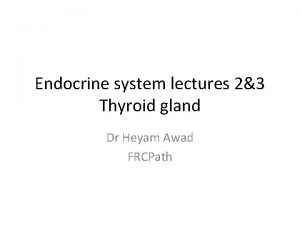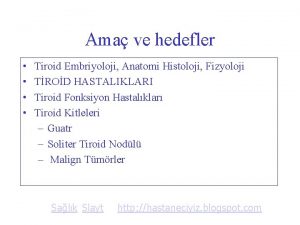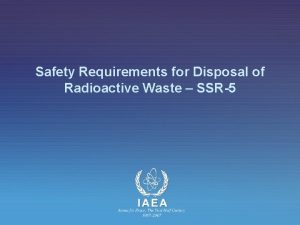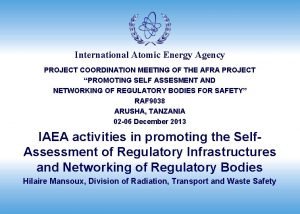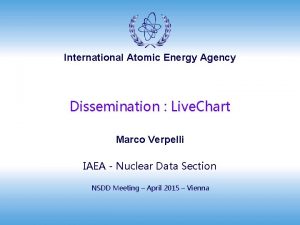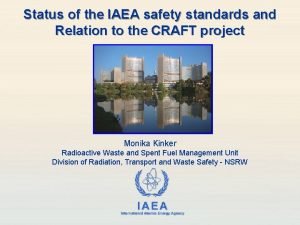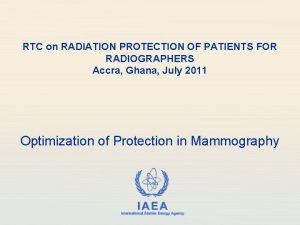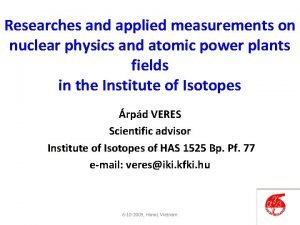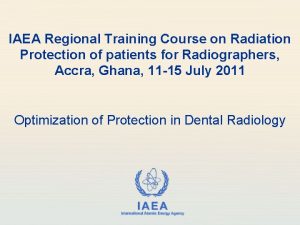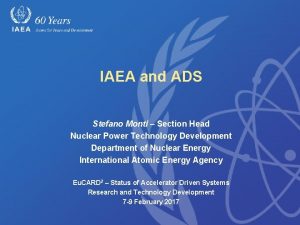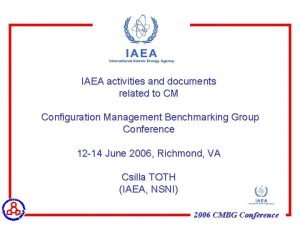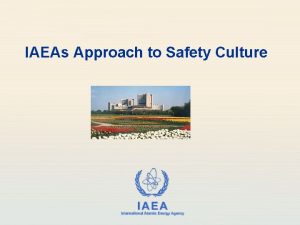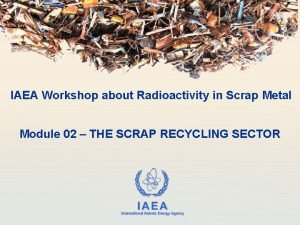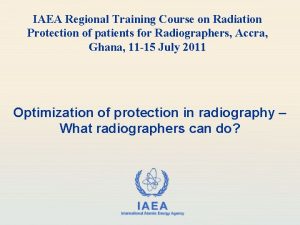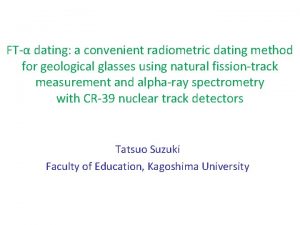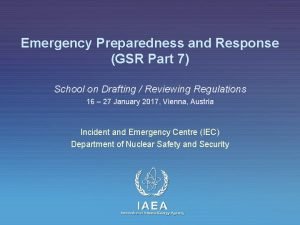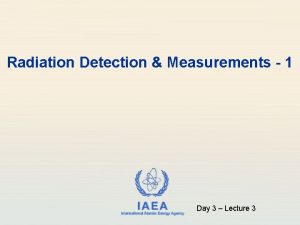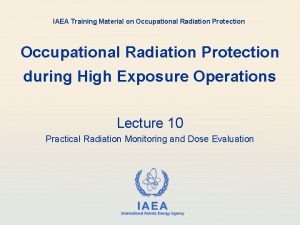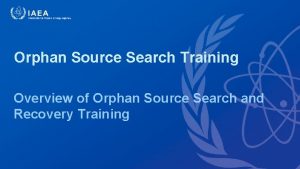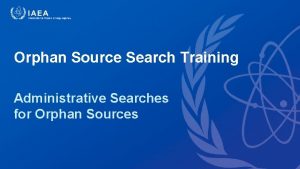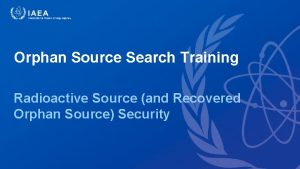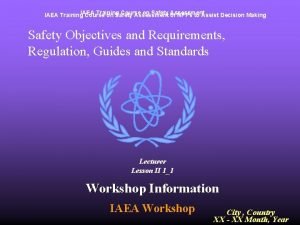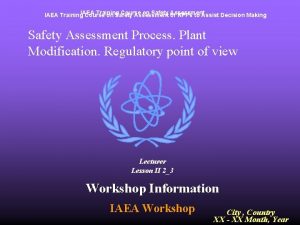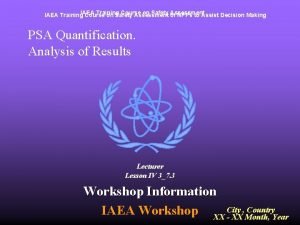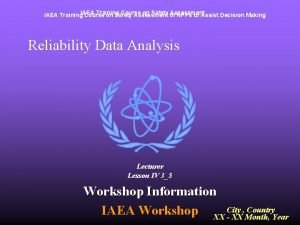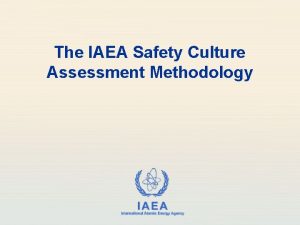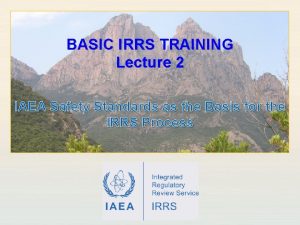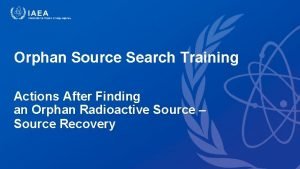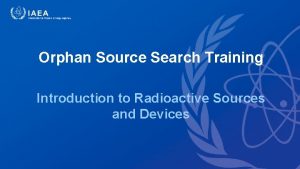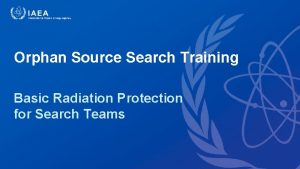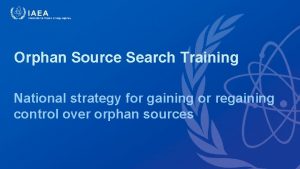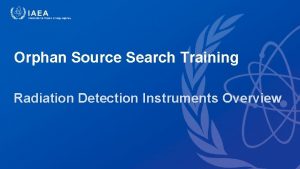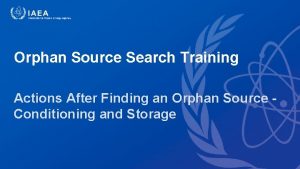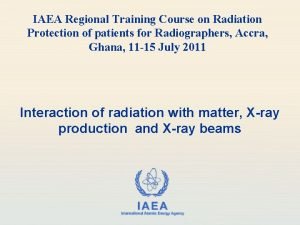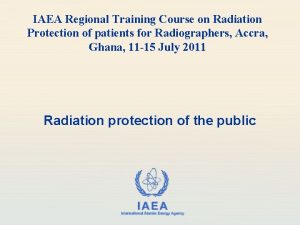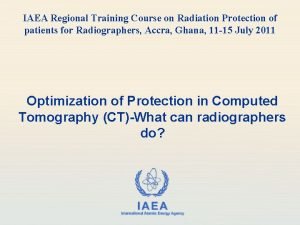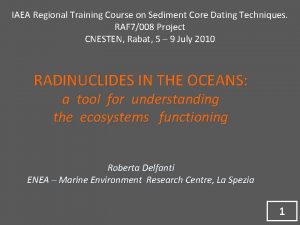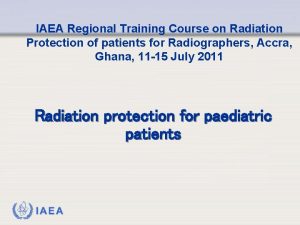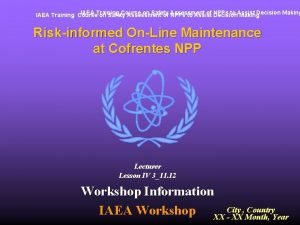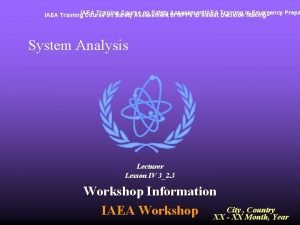IAEA Safety Standards Regional Training Course Orphan Source




























- Slides: 28

IAEA Safety Standards Regional Training Course “Orphan Source Search Training” TC Regional Project RAS/9/062 and RAS/9/085 Philippine Nuclear Research Institute (PNRI) Quezon City, Philippines 17 - 21 October 2016 IAEA International Atomic Energy Agency

IAEA Statute “To establish … standards of safety … and to provide for the application of these standards …” IAEA 2

Why Safety Standards? • IAEA Statute (Article III. A. 6) • “To establish or adopt… [in consultation with…] standards of safety for the protection of health and minimization of danger to life and property” • “…and to provide for the application of these standards” • The IAEA safety standards are • seen as the global reference for nuclear, radiation protection, radioactive waste and transport safety • used by Member States to deliver consistent levels of safety for the protection of workers, the public and the environment IAEA Training Course for Regulators on Enforcement Module 1. 2

Safety Standards as an Element of the Global Safety Regime Knowledge Base Establishing Safety Standards Conventions & International Instruments Rendering Safety Review Services / Appraising Compliance Networking Feedback Promoting E&T Fostering Information Exchange Supporting TC programs IAEA Providing for Application of Standards

1958 IAEA ter 1961 e Ba Sta sic S nd afe ard ty s 1962 N Pro. USS gra mm ion rot ect BS Ra S for dia tio n. P Sa of fe Tr Ra an dio sp act ort ive Ma Sa of fe H Ra and dio lin iso g top es ial History 1974 1996 IAEA Training Course for Regulators on Enforcement Module 1. 2

U Funnified da Sa me fet nta y ls A Plaction n O Str veral uct l ure Co Co mm mm iss itte ion a es nd History (cont’d) CSS COMMISSION ON SAFETY STANDARDS NUSSC RASSC WASSC 1996 IAEA TRANSSC 2003 2004 2006

Lo Ne ng T w F erm orm St at ruct u re History (cont’d) 2008 IAEA 2010 2011

Legal Status of the IAEA Safety Standards • Safety Standards are not binding on Member States, but may be adopted by them. However… • Safety Standards are binding • for IAEA’s own activities. • on States in relation to operations assisted by the IAEA. • on States wishing to enter into project agreements IAEA

Paradigm for developing safety standards 103 The 2007 Recommendations of the International Commission on Radiological Protection Effects of radiation IAEA Recommendations for protection

Safety Standards Fundamental Safety Objective Safety Fundamentals “to protect people and the environment from harmful effects of ionizing radiation” Safety Requirements Safety Guides IAEA Apply to all facilities and activities that give rise to radiation risks 10

Fundamental Safety Principles (2006) • 10 Fundamental safety principles for protecting people against ionizing radiation • Basis for all other IAEA Safety Standards IAEA 11

Fundamental Safety Principles • Safety Principle 1: Responsibility for safety: • The prime responsibility for safety must rest with the person or organization responsible for facilities and activities that give rise to radiation risks. • Safety Principle 2: Role of government: • An effective legal and governmental framework for safety, including an independent regulatory body, must be established and sustained. • Safety Principle 3: Leadership and management for safety: • Effective leadership and management for safety must be established and sustained in organizations concerned with, and facilities and activities that give rise to, radiation risks. IAEA

Fundamental Safety Principles (cont’d) • Safety Principle 4: Justification of facilities and activities: • Facilities and activities that give rise to radiation risks must yield an overall benefit. • Safety Principle 5: Optimization of protection: • Protection must be optimized to provide the highest level of safety that can reasonably be achieved. • Safety Principle 6: Limitation of risks to individuals: • Measures for controlling radiation risks must ensure that no individual bears an unacceptable risk of harm. • Safety Principle 7: Protection of present and future generations: • People and the environment, present and future, must be protected against radiation risks. IAEA

Fundamental Safety Principles (cont’d) • Safety Principle 8: Prevention of accidents: • All practical efforts must be made to prevent and mitigate nuclear or radiation accidents. • Safety Principle 9: Emergency preparedness and response: • Arrangements must be made for emergency preparedness and response for nuclear or radiation incidents. • Safety Principle 10: Protective actions to reduce existing or unregulated radiation risks: • Protective actions to reduce existing or unregulated radiation risks must be justified and optimized. IAEA

Responsibility for safety • The IAEA Fundamental Safety Principles (SF-1) place the prime responsibility for safety on the person or organization responsible for facilities and activities that give rise to radiation risks. • It is the role of the regulatory body to set the rules and to assure compliance • It is the role of the person or organization responsible for facilities and activities, and all other parties having responsibilities for safety, to follow the rules. IAEA

Governmental, Legal and Regulatory Framework for Safety (2010) • General Requirements for • • • the national regulatory infrastructure for safety Regulatory framework Establishment of an effectively independent Regulatory Body Core regulatory functions: Authorization, inspection, enforcement IAEA 16

Transport Safety (2012) • Transport regulations • for all radioactive materials Basis for international transport regulations IAEA 17

Basic Safety Standards (BSS) • International Basic Safety Standards for Protection against Ionizing Radiation and for the Safety of Radiation Sources • Safety Standards Series No. 115 (1996): The recommendations contained in ICRP Publication 60 have been incorporated into the BSS (1996). • The BSS(1996) has been revised taking into account the new ICRP publication 103 • The new BSS is GSR Part 3 (interim, 2011) IAEA Training Course for Regulators on Enforcement Module 1. 2

Basic Safety Standards (2014) • • • A key Standard since 1960, cosponsored by several international organizations Comprehensive set of requirements covering all aspects of radiation protection and safety All exposure situations: planned, emergency, and existing situations All categories of exposed people: workers, patients, public Reference document for national radiation safety regulations IAEA 19

Leadership and Management for Safety-2016 • Sets requirements for establishing, assessing, sustaining and continuously improving effective leadership and management for safety in organizations concerned with, and facilities and activities that give rise to, radiation risks • includes the regulatory body and other competent authorities, and the organization responsible for the facility or for the activity. IAEA 20

IAEA 21

Code of Conduct on the Safety and Security of Radioactive Sources (2004) • • • Not a Safety Standard For Governments and Regulatory Bodies Set of objectives and principles for the control of sources Additional Guidance on import/export Topics include: national register of sources, strategies for disused sources, orphan sources… IAEA 22

State Political Commitment to the Code of Conduct In September 2003, GC urged each State to write to the Director General that: • it fully supports and endorses the Agency's efforts to enhance the safety and security of radioactive sources; and • It is working toward following the guidance contained in the Code and encourages other countries to do the same. (GC 47/Res 7) As of 27 March 2013, 120 States have written to the Director General Made a commitment IAEA Training Course for Regulators on Enforcement Module 1. 2

Basic Principles States should take appropriate measures to ensure that radioactive sources are kept safe and secure throughout their whole life-cycle (recognizing that the prime responsibility is with the authorized user) This requires: Effective national legislation, regulations and a regulatory body paragraphs 7– 22 of the Code; and Effective import/export controls paragraphs 23 -29 of the Code + supplementary Guidance IAEA

SSG-19 National Strategy for Regaining Control Over Orphan Sources and Improving Control Over Vulnerable Sources IAEA 25

RS-G-1. 9 Categorization of Radioactive Sources IAEA 26

SSG-17, Orphan Sources and Other Radioactive Material in the Scrap Metal and Recycling Industries (2012) • Recommendations on meeting safety requirements in relation to the presence of radioactive material in scrap metal • Responsibilities and actions concerning the discovery of radioactive material and regaining control over it • Scope is primarily domestic IAEA 27

Summary • The IAEA establishes safety standards and • • guidance about how to implement them The standards evolve through time and are based on international knowledge and experience Some safety standards are or may be made legally binding At the core are the safety fundamentals followed by the general safety requirements Orphan sources are addressed in several IAEA specific safety standards IAEA 28
 Safety care 2 person stability hold
Safety care 2 person stability hold The orphan boy and the elk dog
The orphan boy and the elk dog Intro to typography
Intro to typography Orphan annie eye nuclei
Orphan annie eye nuclei Orphan train museum kansas
Orphan train museum kansas Orphan products grants program
Orphan products grants program Warm up movie
Warm up movie There is a languid, emerald sea meaning
There is a languid, emerald sea meaning Open orphan investor relations
Open orphan investor relations Gpr65 agonist
Gpr65 agonist Orphan annie hücreleri
Orphan annie hücreleri Ssr5
Ssr5 Saris iaea
Saris iaea Livechart iaea
Livechart iaea Pcmf iaea
Pcmf iaea Part5ds
Part5ds Rtc protective film
Rtc protective film Nuclear wastes
Nuclear wastes Iaea
Iaea Stefano monti iaea
Stefano monti iaea Iaea
Iaea Iaea
Iaea Steel scrap
Steel scrap Iaea
Iaea Iaea
Iaea Gsr part 7
Gsr part 7 Pcmf iaea
Pcmf iaea Film badge
Film badge Iaea
Iaea



